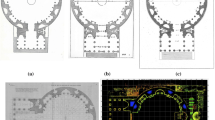Abstract
This research refers to the study of an arch adjoining two rooms of the Pio Clementino Museum, in the Vatican (Rome). This arch was designed by the architect Michelangelo Simonetti (1724–1781) around 1780. The warped intrados of the arch is defined by a flat round arch placed on the wall of the square vestibule and by a hunched curve traced on the cylindrical surface of the next vestibule. The resulting warped surface is a portion of a ruled surface that can be considered a good example of the lathe art and multi-axial modeling. The digital clone analysis demonstrated a double kind of perspective: structural and optical. The first was influenced by the researches on the stereotomic connections of ruled surfaces explained in treatises published in the second half of the 18th century. The second reference can be identified with optical-perspective studies applied to correction of sight like the pictorial decoration by Father Andrea Pozzo (1642–1709) which is present in the Casa Professa’s Chapel (Rome).

















Similar content being viewed by others
References
Blanchard, Edme. 1729. Traité de la coupe des bois pour le revêtement des voutes, arrieres-voussures, trompes, rampes et tours rondes. Utiles aux arts de charpente, menuiserie et marbrerie. Paris: Jacques Josse.
Connors, J. 1990. Ars tornandi: Baroque architecture and the Lathe. Journal of the Warburg and Courtauld Institutes” 53, London, pp- 217–236.
De Lobkowitz, Juan Caramuel. 1678. Architectura civil, recta y obliqua. Vigevano.
De Rosa, A. (2019). Roma anamorfica. Prospettiva e illusionismo in epoca barocca. Rome: Aracne.
De Rosa, A. and D’Acunto, G. 2003. La vertigine dello sguardo. Tre studi sulla rappresentazione anamorfica. Venice: Cafoscarina.
Evans R. 1995. The projective cast: architecture and its three geometries. Cambridge (Mass.): MIT press.
Frézier, Amédée-François. 1737. La théorie et la pratique de la coupe des pierres et des bois pour la construction des voûtes et autres parties des bâtiments civils & militaires, ou Traité de stéréotomie, à l’usage de l’architecture, par M. Frézier. Paris: Charles - Antoine Jombert.
Hulot, M. 1775. L’art du tourneur mecanicien. Paris: Roubo.
Letarouilly, Paul. 1882. Le Vatican et la basilique de Saint-Pierre de Rome, Paris: Vve A. Morel et Cie.
Calvo López, J. 2001. Arquitectura oblicua y trazas de montea. EGE 2. Madrid June, pp. 38–51.
Monduit L. and Denis A. 1889. Traitè théorique et pratique de la stéréotomie au point de vue de la coupe des pierres Paris: Juliot.
Plumier, Charles, 1749. L’art de tourner en perfection toutes sortes des ouvrages au tour. Paris: chez Charles-Antoine Jombert.
Salviucci Insolera, L. 2014. Andrea Pozzo e il Corridoio di S. Ignazio, Rome: Artemide.
Spinola, G. 1996-2004. Il Museo Pio Clementino, voll. 1–3. Rome: L’Erma di Bretschneider.
Derand, François, S. I. 1643. L’Architecture des voûtes ou l’art des traits et coupe des voûtes…, Paris: Sébastien Cramoisy.
Guarini, Guarino, 1671. Euclides adauctus et methodicus mathematicaque universalis…, Torino: Bartholomaei Zapatae.
Guarini, Guarino, 1737. Architettura Civile del padre D. Guarino Guarini chierico regolare opera postuma dedicata a sua sacra reale maesta. Torino: Gianfrancesco Mariesse.
Jousse, Mathurin. 1642. Le secret d’architectvre: décovvrant fidèlement les traits geometriqves, covppes, et dérobemens necessaires dans les bastiments. A La Fleche: G. Griveav.
La Rue, Jean-Baptiste de. 1728. Traité de la coupe des pierres où par méthode facile et abrégée l’on peut aisément se perfectionner en cette science. Paris: Imprimerie Royale.
Milliet-Dechalles, Claude-François, S. I. 1674. Cursus seu mundus mathematicus. Lugduni: Officina Anissoniana.
Author information
Authors and Affiliations
Corresponding author
Additional information
Publisher's Note
Springer Nature remains neutral with regard to jurisdictional claims in published maps and institutional affiliations.
About this article
Cite this article
Bortot, A., De Rosa, A. Warped Curves in the Vestibule Arch of the Pio Clementino Museum, Rome. Nexus Netw J 22, 9–24 (2020). https://doi.org/10.1007/s00004-019-00437-4
Published:
Issue Date:
DOI: https://doi.org/10.1007/s00004-019-00437-4




